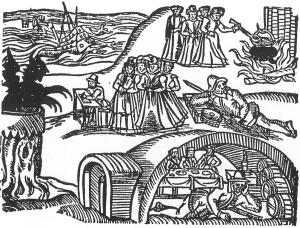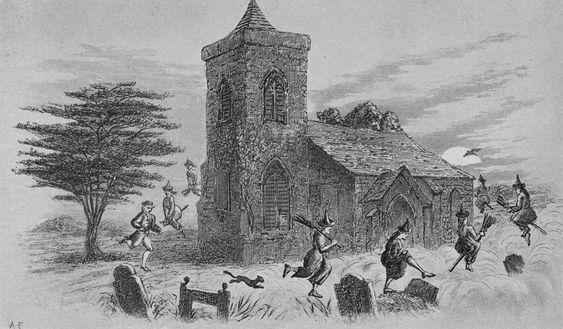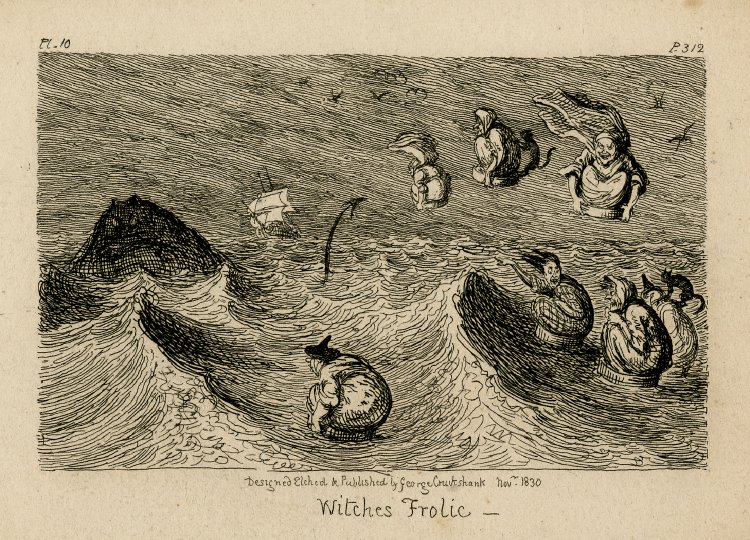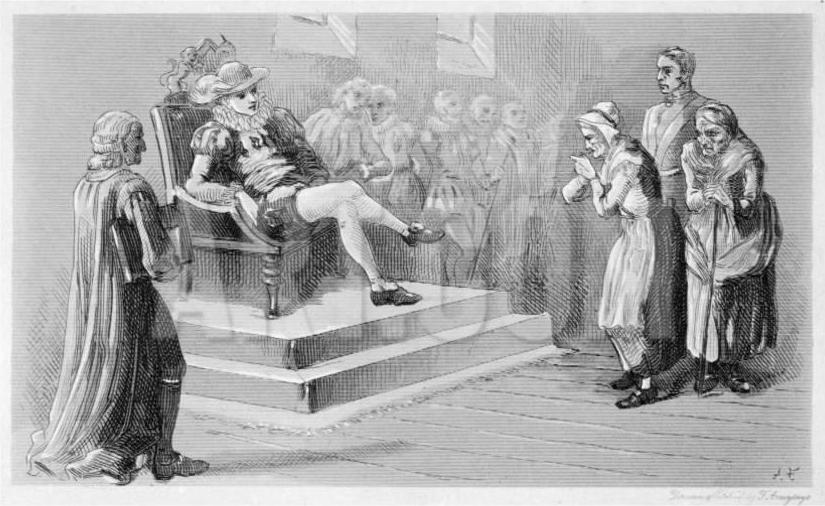
 1591 pamphlet describing the North Berwick witch trials in Scotland, detailing the confessions given by the accused witches before King James VI.
1591 pamphlet describing the North Berwick witch trials in Scotland, detailing the confessions given by the accused witches before King James VI. 1591 pamphlet describing the North Berwick witch trials in Scotland, detailing the confessions given by the accused witches before King James VI., showing some of the scenes described during the North Berwick witch trials
1591 pamphlet describing the North Berwick witch trials in Scotland, detailing the confessions given by the accused witches before King James VI., showing some of the scenes described during the North Berwick witch trialsSurvey of Scottish Witchcraft
Barbara Napier or sometimes Barbara Naper (c. 1554 – sometime between 1592 to 1600) was an Edinburgh woman accused of witchcraft and conspiracy to murder in the series of trials from 1590 until 1592 that become known as the North Berwick witch trials Series of Scottish witch trials held between 1590 and 1593..
Series of Scottish witch trials held between 1590 and 1593..
Barbara was Lady-in-waiting to the Countess of AngusScottish countess named in North Berwick witch trials as consulting with witches until they had a series of disagreements. A member of the high society of Edinburgh, Barbara was a friend of Francis Stewart, the 5th Earl of Bothwell, who was charged with plotting treasonable conspiracy with a group of witches that included Barbara.
At her trial Barbara was found guilty of consulting with witches and sentenced to be strangled and burned, but whether the execution was ever carried out is uncertain. She had claimed to be pregnant, which would have secured a deferral; surviving records are inconsistent as to her eventual fate.
Personal details
Information about Barbara’s personal life is sketchy and far from extensive.[1] According to historian Louise Yeoman, Barbara was born in about 1554; her parents were Alexander Napier of Ingliston and Isobell Litill. Barbara was married twice; around 1572 she married George Ker, a bookseller, who died in France during September 1576.[2] Her second husband was Archibald Douglas, an Edinburgh burgess.[3] The exact wedding date is unknown, but it was probably in 1578.[2] Her indictment indicates her husband was Archibald Douglas and her brother-in-law was the laird of Carschogill; other sources state she was the wife of Archibald Dowglass of Persgill and that her brother was William Napper of Wright’s Houses.[1] She held a high status among Edinburgh society;[4] as her father and her husband pre-deceased her without having any male heirs, she inherited their properties and land.[5][a]In Scotland and England during the sixteenth century spelling was haphazard leading to many words, places and names having several variations. Modern-day texts often use an anglicised version.[6] In some texts Napier is given as Naper
Barbara acted as a lady-in-waiting to Lady Jean Lyon, the Countess of AngusScottish countess named in North Berwick witch trials as consulting with witches,[2] who was the daughter of the eighth Lord Glamis and widow of Archibald Douglas, the eighth Earl of Angus.[7][b]Normand and Roberts give Patrick, 9th Lord Glamis as the Countess’s father,[8] but it appears that Patrick was her older brother.[9] While employed by the Countess, Barbara became acquainted with Francis Stewart, the fifth Earl of Bothwell,[2] who was a significant figure in the series of witchcraft trials.[10] She operated as an intermediary between the Countess and Agnes Sampson Scottish midwife, cunning woman and healer; central figure in the North Berwick witch trials. – an established midwife, cunning woman and healer who had plied her trade since at least 1585 – when the Countess encountered marital problems.[11] Sampson was also approached by Barbara when her relationship with her employer started to breakdown; Sampson applied a charmVerbal charm to be spoken or chanted, sometimes a single magic word such as Abracadabra or the Renervate encountered in the fictional Harry Potter series of books. to a ring that would entice the Countess to look favourably on Barbara.[12] On other occasions, Barbara sought help from the healer when she was concerned about the well-being of her spouse and children. The Countess and Barbara eventually had a disagreement that led to Barbara’s dismissal, which resulted in further arguments between the pair concerning Barbara’s pension.[2]
Scottish midwife, cunning woman and healer; central figure in the North Berwick witch trials. – an established midwife, cunning woman and healer who had plied her trade since at least 1585 – when the Countess encountered marital problems.[11] Sampson was also approached by Barbara when her relationship with her employer started to breakdown; Sampson applied a charmVerbal charm to be spoken or chanted, sometimes a single magic word such as Abracadabra or the Renervate encountered in the fictional Harry Potter series of books. to a ring that would entice the Countess to look favourably on Barbara.[12] On other occasions, Barbara sought help from the healer when she was concerned about the well-being of her spouse and children. The Countess and Barbara eventually had a disagreement that led to Barbara’s dismissal, which resulted in further arguments between the pair concerning Barbara’s pension.[2]
Accusations
Geillis Duncan Young Scottish maidservant suspected of witchcraft by her employer in November 1590. After being tortured, the initial testimony she gave led to the start of the North Berwick witch trials., a young maidservant, was interrogated and tortured by her employer, David Seton, in November 1590 because he suspected her of witchcraft.[13] She confessed to being a witch and went on to name several others, including Barbara. Duncan claimed Barbara had caused the death of the Earl of Angus by witchcraft[14] and that Barbara’s Edinburgh residence was where witches gathered to discuss their plans.[15] The Earl died on 4 August 1588 and, according to the account in Newes from Scotland
Young Scottish maidservant suspected of witchcraft by her employer in November 1590. After being tortured, the initial testimony she gave led to the start of the North Berwick witch trials., a young maidservant, was interrogated and tortured by her employer, David Seton, in November 1590 because he suspected her of witchcraft.[13] She confessed to being a witch and went on to name several others, including Barbara. Duncan claimed Barbara had caused the death of the Earl of Angus by witchcraft[14] and that Barbara’s Edinburgh residence was where witches gathered to discuss their plans.[15] The Earl died on 4 August 1588 and, according to the account in Newes from Scotland 1591 pamphlet describing the North Berwick witch trials in Scotland, detailing the confessions given by the accused witches before King James VI.
1591 pamphlet describing the North Berwick witch trials in Scotland, detailing the confessions given by the accused witches before King James VI. 1591 pamphlet describing the North Berwick witch trials in Scotland, detailing the confessions given by the accused witches before King James VI., the cause was an illness so mysterious that the doctors were powerless to intervene.[16][17] During the days leading up to her execution on 28 January 1591, Agnes Sampson was examined in front of John Gedde, an official of King James. Sampson admitted meeting Barbara to provide her with help and advice, aided by her magical skills.[18]
1591 pamphlet describing the North Berwick witch trials in Scotland, detailing the confessions given by the accused witches before King James VI., the cause was an illness so mysterious that the doctors were powerless to intervene.[16][17] During the days leading up to her execution on 28 January 1591, Agnes Sampson was examined in front of John Gedde, an official of King James. Sampson admitted meeting Barbara to provide her with help and advice, aided by her magical skills.[18]
The first of these assignations was at Dalkeith when Barbara asked Agnes what could be given to the Countess to ease morning sickness; later the pair met at Cameron to discuss how Barbara’s husband could be kept unharmed while he was in the west of Scotland and returned home uninjured by his enemies. A few days later Agnes provided Barbara with a small wax image to place under the bed of those she was afraid of. It was around this time that the charming of the ring took place.[18]
Ritchie GrahamSorcerer, necromancer and wizard. Executed on the last day of February 1592 as part of the North Berwick witch trials, he was an associate of Francis Stewart, fifth Earl of Bothwell., a magician, had been consulted by Barbara for help about her son’s ailments and she had further sought his advice concerning charms. She also asked Graham whether the King would return to Scotland, placing these events in the first six months of 1589.[16]
Accusations that the witches committed acts of treason against the King gradually began to appear at the beginning of 1591; statements made under oath touched on Agnes Sampson having an image at a meeting of witches, but only one person, Donald Robson – an alleged witch from the Highlands – identified it as King James.[19] Robson and another accused witch, Janet Stratton, placed Barbara at the large coven assembly held at Acheson’s Haven on 31 July 1590.[20]
Trials
Barbara was tried on 8 May 1591; the panel for her defence comprised two eminent advocates, John Moscrop and John Russell, together with three of her relatives, Andrew, William and Alexander Napier.[c]John Moscrop was the father-in-law of another of the accused witches, Euphame MacCalzean; he was also the father-in-law of David Seton, Geillis Duncan’s employer and magistrate of Tranent.[21] Moscrop and Russell were coerced into representing her.[22] They raised objections to three of the prospective jurors: John Seton, the brother of Geillis Duncan’s employer; Joseph Douglas of Pumpherstone, who had previously spoken against Euphame MacCalzean Wealthy Scottish heiress and member of the gentry convicted of witchcraft. A key figure in the North Berwick witchcraft trials of 1590–1591. and Barbara; and one of Lord Seton’s tenants who was marginally involved with incidents raised in Barbara’s indictment.[23]
Wealthy Scottish heiress and member of the gentry convicted of witchcraft. A key figure in the North Berwick witchcraft trials of 1590–1591. and Barbara; and one of Lord Seton’s tenants who was marginally involved with incidents raised in Barbara’s indictment.[23]
Barbara was found guilty of consulting with witches – namely Ritchie Graham and Agnes Sampson[24] – but exonerated on the charge of being present at a witches convention.[15] Persons found guilty of consulting with witches were subject to the death penalty, but it had never previously been invoked so the jury were initially averse to applying the sentence to Barbara.[25] Capital punishment was, however, pronounced on 10 May, and she was to be taken to Castle Hill where she was to be bound to a stake beside a fire, strangled to death then her body burned. Barbara then claimed to be pregnant gaining a stay of execution.[26]
King James was unwilling to accept this result and wrote to the jury members insisting a guilty verdict be returned for all charges.[15] It was at the trial of Barbara’s jurors that the allegations she was party to a conspiracy to harm King James unfolded.[27] Charges of conspiring treason with Barbara and other witches were laid against the Earl of Bothwell;[28] he had been incarcerated in Edinburgh Castle since mid-April.[29]
Fate
Barbara’s fate is unclear; she was known to be alive but probably incarcerated in June 1591[30] yet one of the Justiciary Court records indicates she was executed on the day of her trial although her sentence was not proclaimed until 10 May.[31] She may have been executed at Haddington in the second half of 1591 together with five others,[30] but this is uncertain.[2] According to burgh records in Edinburgh she may have been imprisoned until 23 February 1592 – the same length of time as the claimed pregnancy – when William, her brother, posted bail for her.[31]
On 4 December 1591 Geillis Duncan, together with another of the alleged witches named in Duncan’s first statement, Bessie Thomson, was taken to Castle Hill in Edinburgh for execution. Both made lengthy statements retracting their accusations against Euphame MacCalzean[d]MacCalzean had been convicted of witchcraft and was burned alive on 25 June 1591.[32] and Barbara of being involved in witchcraft.[33] When questioned as to why they lied in their confessions both declared they were forced into it by David Seton, his son and others whose names were not revealed.[34]
Notes
| a | In Scotland and England during the sixteenth century spelling was haphazard leading to many words, places and names having several variations. Modern-day texts often use an anglicised version.[6] In some texts Napier is given as Naper |
|---|---|
| b | Normand and Roberts give Patrick, 9th Lord Glamis as the Countess’s father,[8] but it appears that Patrick was her older brother.[9] |
| c | John Moscrop was the father-in-law of another of the accused witches, Euphame MacCalzean; he was also the father-in-law of David Seton, Geillis Duncan’s employer and magistrate of Tranent.[21] |
| d | MacCalzean had been convicted of witchcraft and was burned alive on 25 June 1591.[32] |
